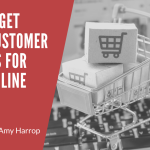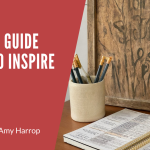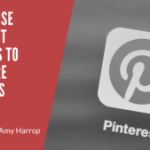This is a guest post from one of my students, Rachel Harrison-Sund. She’s found amazing success with low-content publishing, and offered to share some tips with you. Enjoy!
By Rachel Harrison-Sund
Ever since reading The Four-Hour Workweek by Tim Ferriss I’ve been obsessed with learning how to create a lucrative passive income stream. For me, that book didn’t just represent the possibility of attaining the lifestyle that I’d always quietly dreamed of, it was validation for my years-long feeling that I just didn’t “belong” in the traditional workforce. I could never quite muster a long-term genuine enthusiasm for any of my roles, even after landing my “dream job” as an award-winning Art Director working at a multinational advertising agency. I’m a very driven and ambitious person, but the thought of working my way up the advertising ladder to hopefully, someday, become an 80-hour a week-working Creative Director, seemed highly unappealing, despite the six-figure salary.
But if that wasn’t what I really wanted, then what was I even doing there at all?
Maybe you can relate to this feeling, too: the desire to escape working endless hours, under someone else’s control, for limited compensation—to create more time, more money, and more freedom to pursue the things you really care about. After all, isn’t this what we all really want, deep down? This deep-rooted yearning is what lead me down the passive income path and, ultimately, to create my very own six-figure passive income business.
And it’s been a total game-changer.
- I paid off over $45,000 in student loans that had been weighing me down like a ton of bricks for 7 long years.
- I didn’t have to find a new job when the agency I was working for downsized at the end of 2016, resulting in my being laid off.
- I travel the world regularly because my business is completely location independent.
- I continued to generate $10,000 – $20,000 USD every month while I was caring for my new daughter during her first 6 months of life, even though I didn’t do a single minute of work.
- I maintain my passive income business in just a few hours per week, while my baby is napping. And because it’s so low-maintenance, I’m not worried about going back to work and fretting about being #9,999 on a daycare waitlist.
- I have complete control over my work schedule and lifestyle. My work is built around my life, not the other way around.
MY SECRET SAUCE: LOW-CONTENT PUBLISHING
There are a multitude of ways to generate passive income, and I’ve looked into most of them. In 2014 I began experimenting with self-publishing on Amazon’s KDP (Kindle Direct Publishing) platform as one such avenue, and after publishing titles across the non-fiction, fiction and low-content categories, I can say without a doubt that publishing low-content books is the easiest and quickest way I know of to start earning immediate passive income.
This is because low-content books:
- Take very little time to produce. You can go from idea generation to sales within just a few days.
- Require no special technical knowledge, writing or design expertise to create. There’s no writing involved, and you can either create them yourself in a simple program like Microsoft Word, or outsource them cheaply to someone else.
- Require zero paid advertising, marketing efforts or major upkeep once they are live. Once you’ve created and published your book you now have a royalty-generating asset that will continue to pay you monthly income for as long as your book remains for sale and in demand.
- Require little to no up-front investment. You can create the book yourself, for free, or pay someone else to create the book for as little as $10-$15.
- Don’t require you to carry any inventory. As with any book published on Amazon’s KDP platform, your low-content books will be printed on demand and shipped straight to the customer, meaning you won’t have to store piles of books in the corner of your living room or deal with shipping hassles.
At this point you’re probably saying, “Sounds great, but what the hell are low-content books?”
As the name implies, low-content books contain little to no text or images and are generally repetitive in nature. A few examples of books that fall into this category are:
- Journals and diaries
- Notebooks
- Daily planners
- Bullet journals
- Manuscript paper
- Coloring books
Let’s take the journal as an example. Apart from the front and back cover, the entire book is just page after page of horizontal lines. As you can imagine, a book like this can be produced very quickly and very cheaply. And there’s no need to have any formal design training to create them.
THE 3 STEP FRAMEWORK TO CREATING YOUR FIRST LOW-CONTENT BOOK—THE BASICS
Alright, onto the good stuff.
Here’s a high-level overview of the framework I used to create multiple best-selling low-content books that routinely brought in combined royalties of $10,000 – $20,000 USD every month, allowing me to sky-rocket to six-figures in just 14 months. (For a detailed look at the actual trajectory of my first two years of low-content publishing royalty earnings, check out my 2017 and 2018 Low-Content Publishing Royalty Reports.)
This framework consists of just 3 simple steps:
- Niche Research
- Book Creation
- Publish, Rinse and Repeat
Let’s dive in.
NICHE RESEARCH
The niche research stage is where it all begins, and it should be looked at as having two distinct parts: idea generation and idea validation.
Idea Generation
Start by considering what type of low-content book you might want to start with from our earlier list of examples, grab a pencil and a notepad and begin jotting down your ideas. There are no bad ideas in this stage of the process, so you want to be thinking as broadly as you can while taking inspiration from as many sources as possible. I tend to browse the internet a lot in this early stage and often head straight to Amazon’s Books department to see if I can spot recurring themes, motifs or current trends that I might be able to take advantage of. Keep your thinking cap on until you’ve got a nice list of at least 10-20 ideas you can investigate further. You’ll be discarding many of them in the next stage, so the more you generate now, the more you’ll have left to work with when it comes time to create your first book.
Idea Validation
The Idea Validation stage is the most critical step in the process; it’s all about taking that nice list of ideas you came up with in the first stage and separating the wheat from the chaff. It’s the difference between creating a book that you couldn’t give away to a librarian versus a book that hundreds, if not thousands, will be clamoring to purchase, and then thrilled to leave you a 5-star review for.
The most important thing to remember in this stage is that your ultimate goal is to create a book that people are already searching for so that you can almost guarantee that your book will generate sales before you spend any time creating it. Many self-publishers make the mistake of creating a book that they want to create instead of creating a book that other people want to buy, which, inevitably, results in ZERO sales.
To validate your idea and ensure that you create a book that customers will actually take their wallets out and pay for, you’ll need to answer four specific questions:
- Are customers already actively searching for the book you’re thinking about creating? Remember, you want to create a book that people are already searching for before you spend any time creating it, so that you don’t create a dud that nobody wants.
- Do any similar books already exist? Knowing this will tell you if there is an existing market, or a potentially untapped niche.
- Is anyone actually buying similar books? If similar books are making sales, then you know that there is a paying market for your idea. If not, then there probably isn’t.
- How hefty is the competition? You need to know that your book will stand a chance against the competition that’s already out there.
Once you’ve carried out the Idea Validation process on all of your ideas, you’ll know which ideas to bring with you to the Book Creation stage and which ones to toss into the circular file.
BOOK CREATION
Now that you’ve got a solid list of several viable ideas, you can get to the fun part—creating a recurring-royalty-generating asset! Don’t feel intimidated by this step. Remember, you’re not writing a novel here; you’re creating a simple book full of basic, repeating content.
For this step you’ll need to produce two separate files:
- Manuscript—the interior pages of your book.
- Book Cover—the front, back and spine of your book, created as a single page document.
To create both the manuscript and book cover files you can either design your own or outsource them using a platform such as Fiverr.
Although some knowledge of design is definitely an asset, I want to reinforce that you don’t need to be a graphic designer to make your own manuscript and cover files. There are plenty of places to get high-quality, copyright-free artwork and photographic images that you can download for free. I use these resources myself, even though I’m a designer, because it saves me hours of work and allows me to create beautiful covers in minutes.
If the thought of creating your own manuscript and cover files makes your palms sweat, don’t worry. You can still produce a cover that sells by outsourcing it to someone on Fiverr. Again, even though I’m a designer myself, I often used Fiverr to create my covers when I was publishing nonfiction and fiction books because it saved me time. And outsourcing is fast and cheap: turn-around time for a book cover is usually only a few days and you can get one made for around $10 USD—a miniscule investment considering the potential to make hundreds, if not thousands, of dollars per month in recurring revenue. On the flipside, if you messed up in the Idea Validation stage and your book doesn’t sell a single copy, you’ve only lost $10. A very low-risk investment, indeed.
PUBLISH, RINSE AND REPEAT
You’ve done all the hard work up front and now you’re ready to upload your book to Amazon, hit that publish button and experience the thrill of making your first sale! If you’ve done your due diligence you will have a nice little asset that brings in some dough on a recurring monthly basis. And because you are utilizing Amazon’s print-on-demand service you will never have to deal with any inventory. You will literally just upload your two files, fill in your book details, hit publish and Amazon handles the rest. That’s it! Your book is now for sale on Amazon!
IS THIS BUSINESS MODEL FOR YOU?
Like any business model out there, low-content publishing isn’t for everyone. While you can go from idea generation to making sales within your first week, it does take some time for the momentum to build and, like any other business, requires patience, dedication and commitment to reap the enormous rewards.
In addition, because you will be publishing your books on Amazon, this income stream will be tied to an ever-changing platform that requires you to play by their rules, meaning you won’t have full control of this portion of your business. Therefore, I recommend using this business model to create a low-maintenance side-business that can bring in hundreds, thousands, or tens of thousands of dollars of side income, or, using it as a stepping stone on the path to building a business which is entirely your own and 100% in your control, which is what I’ve done.
With all of this in mind, you’ll know that low-content publishing is for you if:
- You want to create a lucrative, low-maintenance passive income stream that requires little to no upfront investment or ongoing expenses
- You’d like to create a side income to reach a financial goal, such as paying off debt or saving for a down-payment, vacation fund, new car, college tuition, etc.
- You’d like to create a financial cushion that allows you to leave your job and pursue your dream business
- You have the commitment, dedication and patience necessary to build your low-content publishing business over time
Low-content publishing may not be for you if:
- You want to depend on it indefinitely as your primary source of income
- You’re looking to “get rich quick”
- You’re not willing to dedicate at least 3-5 hours per week to building your low-content publishing business.
READY TO GET STARTED?
Now that you’ve seen how Rachel was able to build a six-figure low-content publishing business in just over a year—working just a few hours a week—are you ready to take a crack at it?
Download my free guide, One Page Publishing Secrets.
Inside the guide, I’ll walk you through the entire process from all the options available to you for low- and no-content publishing that’s actually profitable!
I’ll also dive into:
- The hottest types of one-page style content
- How your audience can benefit from one page content
- How to quickly create a beautiful, professional-looking one-pager
Ready?
Download One Page Publishing Secrets now!
To our shared success!




Amy, we are a retirement planning firm helping people (55 to 70). Our focus is investment planning, income planning, health care planning, tax planning and estate planning. We have a weekly radio show and are converting radio content to podcasts. We want to repurpose existing contend to attract “right fit” prospects not to sell the content. We have a writer. What are your recommended products to help attract prospects and convert them to clients?
Hi there,
thanks for your question. I would focus on content marketing to move qualified people through your funnel.
Digital Marketer has a lot of great resources for this:
https://www.digitalmarketer.com/resources/#content-marketing-resources
your save post as pdf to read later does not work
Hi there,
it’s working for me, it just takes a few seconds for the window to popup, please make sure you don’t have your popups blocked.